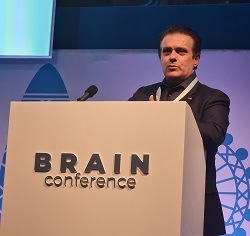
The utilisation of 3D printing to make drug-eluting stents may currently be in its infancy, but the advantages it carries—such as the ability to develop patient-specific devices and tailored drug-release profiles, and evaluate different materials and designs via computational modelling—offer the potential to overcome some key limitations associated with established manufacturing methods.
This was the prevailing message delivered by Dennis Douroumis (University of Greenwich, London, UK) at the 2022 Barts Research and Advanced Interventional Neuroradiology (BRAIN) conference (5–8 December, London, UK), who also highlighted subsequent improvements to the clinical performance of these stents, and to patients’ overall quality of life, that 3D printing may bring.
“We believe that, over the years, improvements to the technological features will render 3D printing as a major manufacturing tool for bioresorbable, drug-eluting stents,” the speaker further asserted.
In a presentation detailing his research involving coronary stents, Douroumis claimed that—while it is thought that bioresorbable stents made from polymers may offer potential benefits compared to their more traditional metal counterparts—the identification of suitable polymers to meet stent specifications and the need for new, optimal drug substances represent two key challenges here.
Outlining the role of 3D printing as a possible solution to this, Douroumis began with a nod to the four key manufacturing methods for bioresorbable, drug-eluting stents—injection moulding, weaving, laser cutting, and 3D printing.
“All of these technologies present some advantages, but most of them have disadvantages [too],” he added. “For example, laser cutting—which is used very often—can cause thermal damage, and create sharp edges on the struts, and it also has high manufacturing costs.”
Even within 3D printing, there are multiple different approaches as well, Douroumis relayed, with the main ones being stereolithography, selective laser sintering, and fused deposition modelling. He went on to state the various advantages associated with these methods, such as the fact that personalised stents can be made to suit an individual patient’s needs and ultimately improve clinical outcomes.
According to Douroumis, other potential benefits of 3D-printed drug-eluting stents include the ability to create complex geometries encompassing a range of shapes and sizes; tailored drug-release profiles that allow more than one drug to be administered; the use of bioresorbable and biocompatible materials; and a reduction in wasted materials.
Douroumis also highlighted some of the work done by him and his team using fused deposition modelling to 3D-print and test a wide range of stent designs. However, owing to the high cost of the filaments used to create these devices, and the fact that printing out and evaluating numerous different prototypes would therefore be extremely expensive, he and his colleagues currently use computational modelling to assess how different materials are likely to perform within different stent designs.
“These [simulations] will give us a prediction of the stent’s mechanical properties,” the speaker added. “[The aim of this exercise] was to develop stents with superior radial recoil, longitudinal retraction, foreshortening and max diametral strain.”
Based on how well a given stent concept performs in these assessments, its design, or the formulation of the polymers used, can be adjusted fairly easily, Douroumis noted.
He went on to emphasise the importance of the very high levels of accuracy and precision that can be achieved with 3D printing, as this enables stents with the correct diameter to be created and increases the likelihood of subsequent treatments with the device being successful. However, the speaker also conceded one major limitation of fused deposition modelling technologies.
“These stents are relatively thick—the thickness varies from 300–400μm—so we [are aiming] to make them much thinner,” Douroumis continued. “We had to manipulate and improve the hardware of the printer a lot and, at the moment, the capacity of these particular printers to go down to better resolutions is a bit limited. But, in the next few years, we might see changes there.”
He stated that, because of this, his team has also begun deploying stereolithography in stent manufacturing as well, owing to its “excellent” print resolution (25μm), and ability to incorporate drugs during the printing process, improve mechanical strength and fabricate ‘shape memory’ stents.
Douroumis concluded by stating that assessments of stereolithography-printed stents at his centre have found that they deviate only marginally from initial device designs, and have a “very smooth surface” with “no defects” and a strut thickness of 150–250μm that is “quite consistent”, before adding that there is “more work to do” and clinical trials of some of these 3D-printed stents are hopefully on the horizon.













